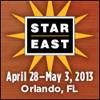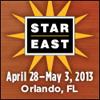 |
STAREAST 2013: Maybe We Don’t Have to Test It
Slideshow
Testers are taught they are responsible for all testing. Some even say “It’s not tested until I run the product myself.” Eric Jacobson believes this old school way of thinking can hurt a tester’s reputation and—even worse—may threaten the team’s success. Learning to recognize...
|
Eric Jacobson, Turner Broadcasting
|
 |
Mobile Testing Methodologies: Trends, Successes, and Pitfalls
Slideshow
In today's dynamic mobile marketplace—where new handsets and mobile operating systems are released every day—your ability to deal with these changes which impact your mobile product is vital. The mobile application lifecycle today must be short; must be of great quality; cover...
|
Eran Kinsbruner
|
|
|
Exposing and Erasing Organizational Bias: An Interview with Keith Klain Keith Klain gives a glimpse at what he'll be discussing at his upcoming STARCANADA session, "Creating Dissonance: Overcoming Organizational Bias toward Software Testing." Learn the numerous benefits of discovering these biases before they do more damage than they've already done.
|
|
|
|
Simplicity and Precision: Test Planning in Agile Projects Test planning is often thought unnecessary in an agile project. However, if our mindset is on "planning" rather than "plans," we see that test-planning activities happen throughout the project, taking advantage of levels of precision, i.e., what is absolutely necessary at each level.
|
|
|
|
Tackling Challenges with Agile Teamwork: An Interview with Janet Gregory Janet Gregory shared with us some of the wisdom she's gained through her decade of experience with building strong agile teams. After defining "agile testing" we discussed how to ensure it succeeds. Janet is giving two sessions at the 2013 STARCANADA conference in Toronto on April 9 and 10.
|
|
 |
Specification-by-Example: A Cucumber Implementation
Slideshow
We've all been there. You work incredibly hard to develop a feature and design tests based on written requirements. You build a detailed test plan that aligns the tests with the software and the documented business needs. When you put the tests to the software, it all falls apart because the requirements were updated without informing everyone. But help is at hand. Enter business-driven development and Cucumber, a tool for running automated acceptance tests. Join Mary Thorn as she explores the nuances of Cucumber and shows you how to implement specification-by-example, behavior-driven development, and agile acceptance testing. By fostering collaboration for implementing active requirements via a common language and format, Cucumber bridges the communication gap between business stakeholders and implementation teams.
|
Mary Thorn, Deutsche Bank
|
 |
Tune Agile Test Strategies to Project and Product Maturity
Slideshow
For optimum results, you need to tune agile project's test strategies to fit the different stages of project and product maturity. Testing tasks and activities should be lean enough to avoid unnecessary bottlenecks and robust enough to meet your testing goals. Exploring what "quality" means for various stakeholder groups, Anna Royzman describes testing methods and styles that fit best along the maturity continuum. Anna shares her insights on strategic ways to use test automation, when and how to leverage exploratory testing as a team activity, ways to prepare for live pilots and demos of the real product, approaches to refine test coverage based on customer feedback, and techniques for designing a production "safety net" suite of automated tests. Leave with a better understanding of how to satisfy your stakeholders’ needs for quality-and a roadmap for tuning your agile test strategies.
|
Anna Royzman, Liquidnet Holdings, Inc.
|
 |
Mock Objects: From Concept to Code
Slideshow
Mock objects are simulated objects that mimic the behavior of real objects in controlled ways. Because many code modules interact with external entities-things like databases, networks, file systems, third-party frameworks, and even the clock-these entities often cause us big-time trouble during unit testing. These entities can slow down our unit tests, produce unpredictable results, and have dangerous side effects. The best unit tests are decoupled from these external entities. Rather than try to control the entities, you can create mock objects to simulate their functionality. With a tangible example in the form of a short play, Rob Myers introduces mock objects and provides a brief history of their "relatives"-stubs and fakes. Then, with an animated, nearly-worst-case example, Rob presents code he developed to "mock out" nasty dependencies and create safe, predictable unit tests.
|
Rob Myers, Agile Institute
|
|
|
The Why and How of Usability and User Experience (UX) Testing
Slideshow
Although usability and user experience may seem synonymous, they are separate and much different concepts. While usability is well defined in standards, UX has no agreed upon definition because it relates to a more nebulous attribute-user satisfaction. Both are, however, key ingredients for successful system deployment. Because they don’t know how to measure and evaluate UX, many teams ignore this important attribute until the end of development. Philip Lew discusses how to model both usability and UX by breaking each attribute down into measurable characteristics-learnability, user effectiveness, user efficiency, content quality, user errors, and more. Phil shows you how to derive measurements and metrics that your development and team can employ to benchmark, analyze, and improve both usability and UX.
|
Philip Lew, XBOSoft
|
|
|
Better Test Designs to Drive Test Automation Excellence
Slideshow
Test execution automation is often seen as a technical challenge-a matter of applying the right technology, tools, and smart programming talent. However, such efforts and projects often fail to meet expectations with results that are difficult to manage and maintain-especially for large and complex systems. Hans Buwalda describes how the choices you make for designing tests can make-or break-a test automation project. Join Hans to discover why good automated tests are not the same as the automation of good manual tests and how to break down tests into modules-building blocks-in which each has a clear scope and purpose. See how to design test cases within each module to reflect that module's scope and nothing more. Hans explains how to tie modules together with a keyword-based test automation framework that separates the automation details from the test itself to enhance maintainability and improve ROI.
|
Hans Buwalda, LogiGear Corporation
|

